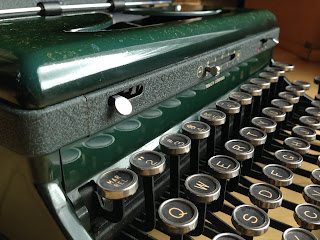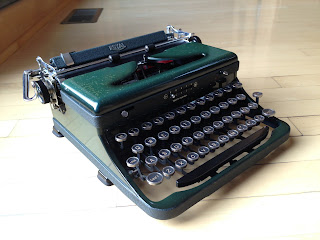1938 Royal Speed King
In the later end of the 1930s, Royal began releasing base model machines with no designation to them. The Model P, the Model O, those are commonly known machines. The Touch Control and the Quiet, the Speed King, the Arrow, the Aristocrat, the Deluxe, and eventually the Quiet Deluxe. The QDL was just the merging of two machines, and that itself spawned many other variations. I'll admit, I myself wasn't aware of the Model A and Model B machines. This is where the discrepancy comes in, I was informed in the comment section that the model letters indicate a hierarchy of models, not necessarily a chronological order, and that the Model B was advertised as the Speed King, which it later became known to be. So perhaps in this "edit" so to say, I should rename the title of the article: the "1938 Royal Speed King."
Anyways, in first finding out about these differing models, I posted a photo to my favorite Instagram group chat, the Baker Boys, (long story,) and had some discrepancy about what it was called. I referred to it as a Model O, but Kai Razon (another brilliant technician) referred to it as, the then unknown to me, Model A. After a quick look through the web, I discoverd the model was actually a B, a designated machine type according to the serial code.
This machine was another repair job for avid collector Richard Mohlman, who goes by the handle Ramtiques. When I got it, the right margin was pushed center, and the carriage, when returned, didn't latch onto the escapement. I knew instantly what the problem was, but was afraid to admit it to myself. Royal escapement pawls are very thin. This is the piece that holds onto the star wheel, preventing the carriage from moving unless a key is pressed. When the key is pressed, it lifts the rocker plate which allows for the toothed star wheel to slip off the pawl holding it in place. This thin piece of tempered steel is all that holds the carriage in position, and if the machine is dropped or poorly shipped, this will sheer in half. That is unfortunately what happened.
Assessing the problems
I had to remove the carriage
I took an orange sharpie to the broken part
marked the index point of the ball bearings which I'd later hand reset
Removing the carriage was the easy part. There is a small set screw (some weirdos call this a grub screw or a worm screw. Grub sure, but worm refers to a different class all together.) then the entire carriage slides completely off the rails. This is very simple, as opposed to other machines which have a variety of things in the way of the carriage removal. Now here is the important bit. In order to access the pawl screw, I needed to remove the rocker plate from the machine. This is done by undoing the pivot screw located by the rear carriage rail, just to the right of the vertical margin bar and line lock. You can only access the screw from the Shift Lock position, slipping the screwdriver underneath the rail. NOTE: the carriage doesn't need to be off for this, I just had it off to diagnose the issue.
On the older models, In addition to the tension spring, the spacebar also makes a physical linked connection to the rocker plate. This will be important to note later on. The linkage bar needs to be opened up with a pair of pliers, and removed from its slot on the rocker plate. There are two holes, the top is for the tension spring, and the bottom is for the spacebar. After that, it should just drop out the bottom, it'll be like removing the pick from the sound hole of an acoustic guitar.
Of course I forgot to take photos of the replacement part and all the other crap I'll be talking about, so I'll try and be descriptive. The damaged screw you see is what's holding the pawl to the rocker plate. This screw actually snapped the head of my best screwdriver in half, so I'm pretty upset about that. I ended up having to drill it out to remove the broken part. I headed over to Richard's house for a replacement, and while I was there I got to see his amazing collection of typewriters, and typewriter tools. He loaned me a set of keytop removal tools, which ended up breaking five keys of mine in a post I'll be writing later on. (Jon Posey is sending me new ones, many thanks to him). He introduced me to a 50s era Quiet Deluxe in rather poor shape. From it, he asked me to harvest two parts. The @ key bar and slug, and the rocker plate for the B model. It only took me five minutes to transplant the slug and keybar onto the machine that needed it, and a few more moments to extract the plate. Here's where that bit of info I had you note comes into play. The QDL doesn't require a physical connection from the spacebar to the rocker plate, instead, it just bumps up against it and moves it. Therefore there are no holes drilled, which is why the entire rocker plate cant be replaced, and why I had to do what I did. The screw and the pawl from the QDL went home with me that afternoon, and I set about placing it into the B model, however the plate was tempered steel and the screw was a millimeter too big. I did what any sane person would do, I took a hammer and pounded the screw into place, essentially using it as a rivet rather than a screw. I know I know, bad Lucas. I did what I had to do, trust me, there was no other way to install the part.
From then on it was just putting the machine back together agian.
Polishing
cleaning
spring replacing
and carriage resetting
My hell wasn't over yet. Ever replaced royal ball bearings? Each one of these tiny steel balls has to fit in the center of the little stars. There are four, and they have to be centered inside the carriage rails. Sounds simple right? There's a little tool that holds them in the correct alignment, and gets into the tiny places they need to go, but I don't have said adorable little tool. I had my fingers. It took an hour. I've done it before, and I disliked it then. I disliked it now too in case you were wondering.
The machine is done, beautiful, working, and intact. What a unique piece! Lovely color on a non-flagship model. Truely a rare piece that Richard, or whoever may buy it from him will be very lucky to have.





















I was led to believe by people who seem to know that your "Model B" is an early Speed King and was called that in Royal's advertising. I also think it is a poor assumption to assume the A came before the B... that would be like saying the Quiet De Luxe predated the Aristocrat which then predated the Arrow (serial prefixes A, B, and C respectively). The serial prefix represents a model hierarchy not a temporal lineage.
ReplyDeleteWell thank you very much! It can be a confusing thing to organize at times!
DeleteColored ones are not as common. I was told you could spot a Speed King by the crinkle band if you don't see the serial or know well which features were on them. I have one of the "Model A"s you mention... I still call it a P, but it has a tabulator and everything and I think A just represented the top of the line at the time. For the most past these machines were referred to by Royal as "the Royal Portable" which doesn't satisfy collectors these days looking to name them.
Delete